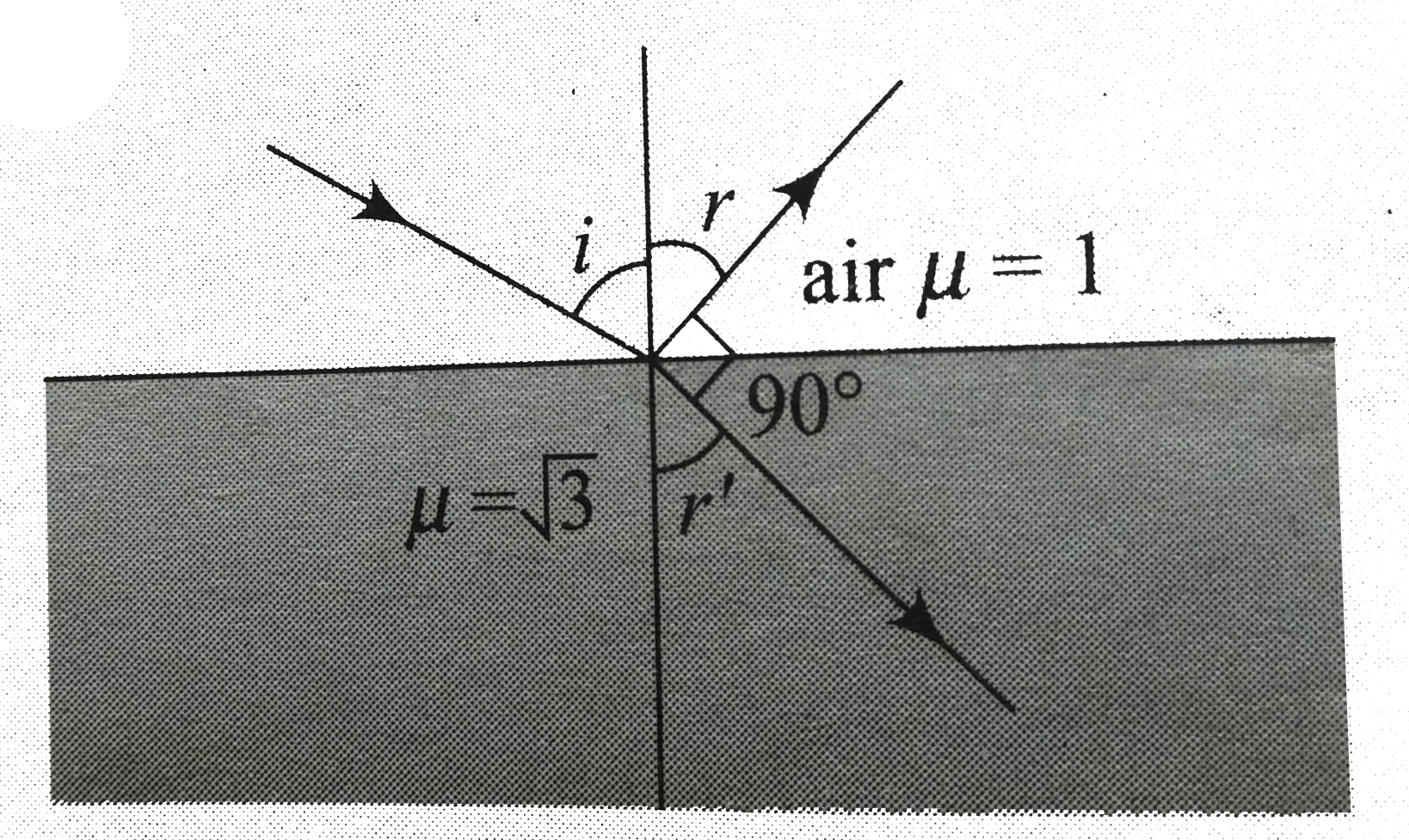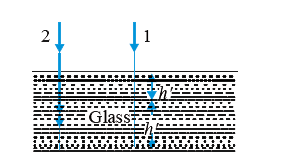When light is polarised by reflection from a transparent surface.
a) reflection and refracted rays are mutually perpendicular
b) both reflected and refracted rays are plane polarised
c) refraction ray is partially polarised
d) the R.I., of transparent surface is equal to tangent of Brewster.s angle
only a and c are true
only b, c and d are true
only a, c and d are true
only a and d are true
The correct Answer is:C
To solve the question regarding the polarization of light by reflection from a transparent surface, we will analyze each of the given statements one by one.
1. Understanding Polarization by Reflection:
- When light strikes a transparent surface, part of it is reflected and part is refracted. The reflected light can become polarized depending on the angle of incidence.
2. Analyzing Statement A:
- Statement A: "Reflection and refracted rays are mutually perpendicular."
- According to the laws of reflection and refraction, at Brewster's angle (the angle at which light is perfectly polarized upon reflection), the angle between the reflected ray and the refracted ray is indeed 90 degrees. Thus, this statement is true.
3. Analyzing Statement B:
- Statement B: "Both reflected and refracted rays are plane polarized."
- The reflected ray is plane polarized, but the refracted ray is only partially polarized. Therefore, this statement is false.
4. Analyzing Statement C:
- Statement C: "Reflected ray is partially polarized."
- The reflected ray at Brewster's angle is fully polarized, not partially. Hence, this statement is false.
5. Analyzing Statement D:
- Statement D: "The R.I. of transparent surface is equal to tangent of Brewster's angle."
- According to Brewster's law, the refractive index (R.I.) of the transparent surface is indeed equal to the tangent of Brewster's angle. This statement is true.
6. Conclusion:
- From the analysis, we find that statements A and D are true, while statements B and C are false.
Final Answer:
- The correct options are A and D.
- When light strikes a transparent surface, part of it is reflected and part is refracted. The reflected light can become polarized depending on the angle of incidence.
- Statement A: "Reflection and refracted rays are mutually perpendicular."
- According to the laws of reflection and refraction, at Brewster's angle (the angle at which light is perfectly polarized upon reflection), the angle between the reflected ray and the refracted ray is indeed 90 degrees. Thus, this statement is true.
- Statement B: "Both reflected and refracted rays are plane polarized."
- The reflected ray is plane polarized, but the refracted ray is only partially polarized. Therefore, this statement is false.
- Statement C: "Reflected ray is partially polarized."
- The reflected ray at Brewster's angle is fully polarized, not partially. Hence, this statement is false.
- Statement D: "The R.I. of transparent surface is equal to tangent of Brewster's angle."
- According to Brewster's law, the refractive index (R.I.) of the transparent surface is indeed equal to the tangent of Brewster's angle. This statement is true.
- From the analysis, we find that statements A and D are true, while statements B and C are false.
- The correct options are A and D.
Topper's Solved these Questions
- WAVES OPTICSBOOK - AAKASH SERIESCHAPTER - WAVES OPTICSEXERCISE - EXERCISE -IA (MATCHING TYPE QUESTIONS)
6 Videos
- WAVES OPTICSBOOK - AAKASH SERIESCHAPTER - WAVES OPTICSEXERCISE - EXERCISE -IA (ASCENDING AND DSCENDING ORDER TYPE QUESTIONS)
6 Videos
- WAVES OPTICSBOOK - AAKASH SERIESCHAPTER - WAVES OPTICSEXERCISE - EXERCISE -IA (SATEMENT TYPE QUESTIONS)
12 Videos
- WAVESBOOK - AAKASH SERIESCHAPTER - WAVESEXERCISE - EXERCISE-III (Doppler effect :)
15 Videos
Similar Questions
A ray of light falls on a transparent glass slab of refractive index 1.62. If the reflected ray and the refracted rays are mutually perpendicular, what is the angle of refraction ?
View SolutionA ray of light is incident on a transparent glass slab of refractive index √3. If the reflected and refracted rays are mutually perpendicular, what is the angle of incidence?

View Solution
Knowledge Check
Unpolarized light is incident on a plane glass surface. The angle of incidence so that reflected and refracted rays and perpendicular to each other, then
Ataniβ=μ2Btaniβ=μCsiniβ=μDcosiβ=μ
A ray of light falls on a transparent glass slab of refractive index √2. If the reflected and refracted rays are mutually perpendicular, then the angle of incidence is
View SolutionA ray of light is incident at an angle i from denser to rare medium. The reflected and the refracted rays are mutually perpendicular. The angle of reflection and the angle of refraction are respectively r and r'. Then the critical angle will be:

View SolutionA light ray is travelling from air to glass. True reflected and refracted rays are perpendicular to each other. If the angle of incidence in air is I the refractive index of glass is
View SolutionA ray of light entering from air to glas (μ=1.5) is partly reflected and partly refracted. lf the reflected and refracted rays are at right angles to each other, the angle of refraction is
View SolutionA : When an unpolarised light is incident on a glass plate at Brewster angle, the reflected ray and refracted ray are matually perpendicular.
R : The refractive index of glass is equal to sine of the angle of polarisation.
View SolutionA ray of light is incident on a transparent medium at polarizing angle. What is the angle between the reflected ray and the refracted ray .
View SolutionAssertion : If light is polarised by reflection, then the angle between reflected and refracted ray is 180∘.
Reason : Brewester's law : μ=tanip.
View Solution
